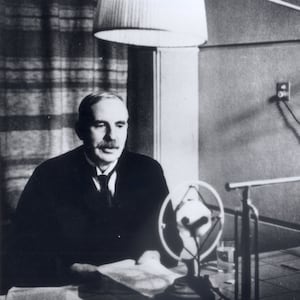World
Hawke’s Bay Author Explores Ernest Rutherford’s Enduring Legacy

Historian and author Matthew Wright has released a new book titled Ernest Rutherford and the Birth of Modern Physics, shedding light on the profound impact of Ernest Rutherford, one of New Zealand’s most celebrated scientists. This publication seeks to clarify misconceptions surrounding Rutherford’s groundbreaking contributions to modern science, particularly his work on atomic structure, which earned him the Nobel Prize in Chemistry in 1908.
Rutherford, born in Napier, New Zealand, is primarily known for his pioneering research in nuclear physics, including the famous experiment that led to the splitting of the atom. His legacy extends beyond scientific achievements; he also appears on the New Zealand $100 bill, symbolizing his national significance. Wright emphasizes that despite Rutherford’s monumental contributions, there has been “an awful lot of misinformation” regarding his work and its implications.
Unraveling Misconceptions
In his book, Wright tackles the common misconceptions about Rutherford’s legacy, arguing that many interpretations fail to capture the true extent of his impact on science. “When I say misinformation, it’s simply that it understates what he did,” Wright stated. His passion for accurately representing Rutherford’s life and work motivated him to write this comprehensive biography, aiming to provide a clearer understanding of how Rutherford’s discoveries have shaped modern technology.
Wright’s research highlights not only Rutherford’s scientific achievements but also his personal journey. He describes how Rutherford’s early life in New Zealand laid the groundwork for his later successes in Europe. His time at the University of Cambridge, where he conducted groundbreaking experiments, is particularly noted for establishing the framework for future research in nuclear physics.
Rutherford’s Influence on Science
Rutherford’s work fundamentally changed the understanding of atomic structure. His most significant contribution, the gold foil experiment, demonstrated the presence of a dense nucleus within the atom, leading to the development of the Rutherford model of the atom. This model set the stage for further advancements in atomic theory, influencing future scientists, including Albert Einstein, who referred to Rutherford as a second Isaac Newton.
Wright’s book not only illuminates Rutherford’s scientific feats but also serves as a reminder of the importance of accurate historical representation. By addressing the myths that surround Rutherford, Wright hopes to inspire a new generation of scientists and historians to appreciate the foundational work that has shaped modern physics.
As the world continues to grapple with complex scientific challenges, understanding the contributions of figures like Ernest Rutherford becomes increasingly essential. Wright’s commitment to preserving Rutherford’s legacy ensures that his profound influence on science will not be forgotten.
-

 World1 week ago
World1 week agoPrivate Funeral Held for Dean Field and His Three Children
-

 Top Stories2 weeks ago
Top Stories2 weeks agoFuneral Planned for Field Siblings After Tragic House Fire
-

 Sports3 months ago
Sports3 months agoNetball New Zealand Stands Down Dame Noeline Taurua for Series
-

 Entertainment3 months ago
Entertainment3 months agoTributes Pour In for Lachlan Rofe, Reality Star, Dead at 47
-

 Entertainment2 months ago
Entertainment2 months agoNew ‘Maverick’ Chaser Joins Beat the Chasers Season Finale
-

 Sports3 months ago
Sports3 months agoSilver Ferns Legend Laura Langman Criticizes Team’s Attitude
-

 Sports1 month ago
Sports1 month agoEli Katoa Rushed to Hospital After Sideline Incident During Match
-

 World2 weeks ago
World2 weeks agoInvestigation Underway in Tragic Sanson House Fire Involving Family
-

 Politics2 months ago
Politics2 months agoNetball NZ Calls for Respect Amid Dame Taurua’s Standoff
-

 Top Stories2 weeks ago
Top Stories2 weeks agoShock and Grief Follow Tragic Family Deaths in New Zealand
-

 Entertainment3 months ago
Entertainment3 months agoKhloe Kardashian Embraces Innovative Stem Cell Therapy in Mexico
-

 World4 months ago
World4 months agoPolice Arrest Multiple Individuals During Funeral for Zain Taikato-Fox



















